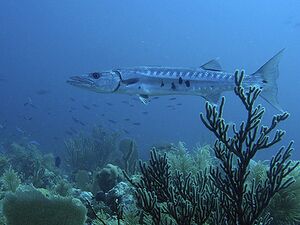Sphyraena barracuda

Great barracuda, barracuda - Sphyraena barracuda
Habitat Barracuda can be found around coral reefs, seagrasses and mangroves. Additionally, they can be found living in the open ocean. Barracuda tend to live near the surface, however, they have been found as far down as 325 feet. Usually these fish are solitary, but they can be found in small groups. Generally, juveniles live in habitats that permit hiding from predators. As they age they move towards reef habitats.
Range These fish can be found around the world. They are found in nearshore regions from 30 degrees North to 30 degrees South.
Description Barracuda are a long torpedo shaped fish. At maturity these fish can grow to be 4.9 feet long and weigh over 103 pounds. They have a pointed snout that contains two rows of sharp teeth. The fish is a blue color on its dorsal side and a white to silver color on its ventral side. Barracuda are capable of bursts of to 35 mph. Barracuda capture their prey in an ambulatory manner.
Ecological Notes Prey of Barracuda include jacks, grunts, groupers, snappers, small tunas, mullets, killifishes, herrings and anchovies. Barracuda have a long gape and sharp teeth which often results in larger prey getting chopped in half. When barracuda reach maturity the have few predators due to their speed and large size. Small barracuda can fall prey to goliath grouper, sharks, and tuna.
Personal Information I first experienced this fish at the North Carolina Aquarium on Roanoke Island. It was located in the aquariums largest tank. I appreciated that the fish wasn't the biggest in the tank but it still seemed to be a top predator. Personally, what makes this fish interesting to me is its striking similarity to Northern Pike which is my favorite freshwater fish.
Journal Articles Wilson, S. K., Wilson, D. T., Lamont, C., & Evans, M. (2006). Identifying individual great barracuda Sphyraena barracuda using natural body marks. Journal Of Fish Biology, 69(3), 928-932. doi:10.1111/j.1095-8649.2006.01128.x
This article shows that it is possible to identify individual barracuda based off of their markings.
D'Alessandro, E., Sponaugle, S., Llopiz, J., & Cowen, R. (2011). Larval ecology of the great barracuda, Sphyraena barracuda, and other sphyraenids in the Straits of Florida. Marine Biology, 158(12), 2625-2638. doi:10.1007/s00227-011-1771-y
This article examines the larval ecology of barracuda. Specifically, it looks at how size and diet effect the growth and survival of the fish.
Other Sources: https://www.floridamuseum.ufl.edu/fish/discover/species-profiles/sphyraena-barracuda Contributed by Michael Williams - 2018